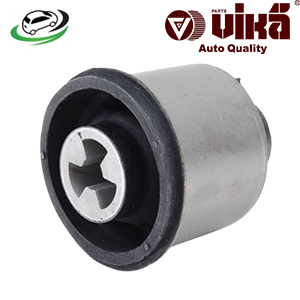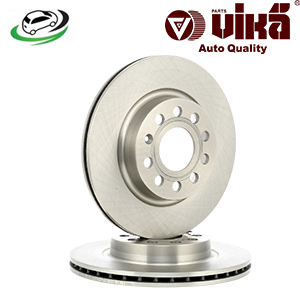-8%
Get Front Brake Disc VW Golf Mk5/Mk6/Caddy III/Beetle/Jetta 2.5L L5 2011 / Audi A3 (8P1) 1.6 2003-2012 1K0615301S
The brake disc, also known as a brake rotor, is a critical component of a vehicle’s braking system. It works in conjunction with the brake pads and calipers to slow down and stop the vehicle by converting kinetic energy into thermal energy through friction. This detailed exploration will cover the construction, function, benefits, common issues, signs of failure, and maintenance of brake discs.
Construction and Function of a Brake Disc
Construction:
- Materials:
- Cast Iron: The most common material due to its excellent heat dissipation and durability.
- Carbon Composite: High-performance vehicles often use carbon composite discs for superior heat management and reduced weight.
- Ceramic: Some high-end and performance vehicles use ceramic discs for their high heat tolerance and lightweight properties.
- Design:
- Vented Discs: These have internal vanes that increase surface area for better cooling. They are typically used on the front brakes where heat buildup is more significant.
- Solid Discs: These are simpler and less expensive but offer less cooling efficiency. They are often used on rear brakes.
- Drilled and Slotted Discs: These designs further enhance cooling and help remove debris from the braking surface.
Function:
- Heat Dissipation:
- Thermal Management: The brake disc’s primary function is to dissipate the heat generated by friction between the brake pad and the disc. This prevents overheating and maintains braking efficiency.
- Friction Surface:
- Stopping Power: The disc provides a surface for the brake pads to press against, creating the friction necessary to slow down and stop the vehicle.
- Structural Support:
- Durability: The brake disc needs to be strong enough to withstand the forces exerted during braking without warping or cracking.
Benefits of a Brake Disc
- Efficient Braking:
- Responsive Stopping: Brake discs provide efficient and reliable braking, ensuring the vehicle can stop quickly and safely.
- Consistent Performance: They offer consistent braking performance across various driving conditions.
- Heat Management:
- Better Cooling: Vented and drilled/slotted discs dissipate heat more effectively, reducing the risk of brake fade during heavy or prolonged braking.
- Maintained Performance: Effective heat management ensures that braking performance is maintained even under strenuous conditions.
- Durability:
- Longevity: High-quality brake discs are designed to withstand the rigors of regular driving, providing long-lasting performance.
- Resistance to Wear: Advanced materials and designs, such as carbon composite and ceramic, offer superior resistance to wear and deformation.
- Safety:
- Reliable Operation: Properly functioning brake discs are crucial for the overall safety of the vehicle, ensuring it can stop effectively when needed.
- Enhanced Control: Good brake discs contribute to better control of the vehicle, particularly in emergency situations.
Common Issues with Brake Discs
- Warping:
- Heat Stress: Repeated heating and cooling cycles can cause the brake disc to warp, leading to vibration and reduced braking efficiency.
- Improper Installation: Incorrect installation or torquing of the discs can also lead to warping.
- Cracking:
- Thermal Cracks: Extreme heat can cause the surface of the brake disc to crack, particularly in drilled or slotted discs.
- Stress Cracks: Over time, the constant stress of braking can lead to cracks in the disc material.
- Wear:
- Surface Wear: Continuous friction causes the surface of the brake disc to wear down, reducing its thickness and effectiveness.
- Grooving: Debris or worn brake pads can create grooves in the disc surface, affecting braking performance.
- Corrosion:
- Environmental Exposure: Brake discs are exposed to moisture and road salts, which can lead to rust and corrosion, particularly if the vehicle is not driven regularly.
Signs of Failing Brake Discs
- Vibrations:
- Steering Wheel Shakes: A warped brake disc can cause vibrations felt through the steering wheel when braking.
- Brake Pedal Pulsations: The brake pedal may pulsate during braking if the discs are uneven or warped.
- Noises:
- Squealing or Squeaking: Worn or damaged brake discs can cause high-pitched squealing or squeaking noises.
- Grinding: A grinding noise often indicates that the brake pads have worn down to the metal, which can damage the discs.
- Reduced Braking Performance:
- Longer Stopping Distances: If the brake discs are worn or damaged, the vehicle may take longer to stop.
- Brake Fade: Overheating can lead to brake fade, where the brakes become less effective the more they are used.
- Visual Inspection:
- Surface Cracks: Visible cracks on the surface of the brake disc are a clear sign of damage.
- Uneven Wear: Inspecting the discs for uneven wear or grooving can indicate problems.
Maintenance and Replacement of Brake Discs
- Regular Inspections:
- Visual Checks: Regularly inspect the brake discs for signs of wear, cracks, or other damage.
- Thickness Measurement: Use a micrometer to measure the thickness of the brake discs and ensure they are within the manufacturer’s specifications.
- Timely Replacement:
- Replace When Worn: Replace the brake discs when they reach the minimum thickness specified by the manufacturer.
- Use Quality Parts: Opt for high-quality brake discs that match the specifications of your vehicle for optimal performance and safety.
- Proper Installation:
- Professional Service: Have brake discs installed by a professional to ensure they are correctly fitted and torqued to the manufacturer’s specifications.
- Bed-In Process: Follow the recommended bed-in procedure after installation to ensure the brake pads and discs work together effectively.
- Routine Maintenance:
- Brake Fluid: Regularly check and replace brake fluid as needed to ensure optimal brake performance.
- Brake Pads: Inspect and replace brake pads regularly to prevent damage to the brake discs.
- Cleanliness: Keep the braking system clean and free from debris to prevent contamination and wear.
Follow us on Facebook for more parts.



